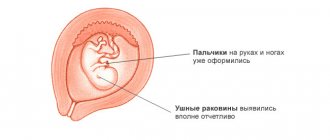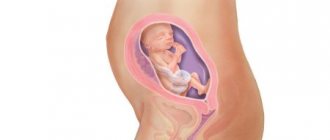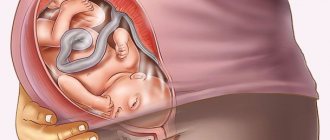The doctor will tell you that the ultrasound at 35 weeks of pregnancy is planned. Doctors will see how the fetus develops, is there a threat to its life when the umbilical cord is located around the neck or head? If the ultrasound shows this position of the baby, then the mother can be prepared for a caesarean section. However, in later weeks of fetal development, additional examination can be done to make a final decision on how the birth will proceed?
- How do the expectant mother and baby feel in the womb?
- How does the fetus develop at 35 weeks of gestation?
- What will a fetal ultrasound show?
- What kind of discharge occurs at this stage of gestation?
- Is there a birth at 35 gestations?
How do the expectant mother and baby feel in the womb?
A baby's nails grow longer and longer in the womb. His movements are not sufficiently coordinated, constrained, he can accidentally scratch his face. Don't be surprised if you notice scratches on your newborn's face. Gradually, the baby gains weight and moves lower in the uterus. He is already quite cramped in the womb.
The fluff disappears from the body, but the fatty lubricant still remains, especially in the shoulder area. Sometimes the mother's cervix can open 10 cm. Painful false contractions begin. The baby quickly gains weight and at 35 weeks it reaches 2.5 kg.
During this period, a woman should adhere to a dietary diet. The fruit puts pressure on the stomach and its volume decreases.
"Advice. It is best to eat 6 or 7 times a day and keep the portions small. Try not to get upset over little things and stay calm.”
You can do exercises in the morning or afternoon. At a measured pace. This will help avoid stagnation of blood in the pelvis and throughout the body.
A woman feels a frequent urge to urinate as the fetus puts pressure on the bladder. Many people have difficulty falling asleep and sleep anxiously. Expectant mothers are visited by thoughts and experiences associated with the upcoming birth. After all, 35 weeks is 8.5 months. carrying a baby, because there are 28 days in an obstetric month.
Set yourself up for the positive that you will reach your due date and will soon give birth to a healthy baby.
Ideally, a woman carries a baby for 280 days or 9 months. according to the calendar or 10 obstetrics. Over each week, the baby in the womb grows, develops, and gains weight, preparing for birth.

"Important. At this stage, the baby in the womb is able to distinguish what is happening in the external environment. He sees when the light gets brighter and gets scared by loud noises. The baby begins to adhere to its daily routine, and when it is born, it is adjusted.”
What happens to mom at 35 weeks

It becomes more difficult for you to walk and move. Due to the fact that the uterus is constantly increasing in size, you may experience pain in the hypochondrium. In addition, it can make breathing difficult because it simply falls on the diaphragm and lungs. The belly continues to grow, causing you more and more inconvenience and trouble. Until this time, a woman usually gains 10-13 kg . You can see a photo of bellies at 35 weeks of pregnancy above.
To reduce fatigue, do not go on too long or long walks. You should also avoid sitting in the same position for a long time to prevent your legs and back from becoming numb. It’s better to change your position, get up and walk around, give yourself a little warm-up. This will help you get rid of not only discomfort, but also possible swelling.
If you notice that your belly button has begun to protrude forward, do not be alarmed. After the baby is born, it will return to normal.
The bladder and intestines also suffer greatly due to the enlarged uterus. You may experience frequent urination, heartburn, constipation, bloating, and heaviness in your stomach. To minimize these troubles, take good care of proper nutrition, do not overeat and consume less fluid at night.
At this stage, the baby intensively consumes calcium , taking it from your body. It is worth making sure that both you and the child do not need this, as well as other useful elements and vitamins.
Possible fears and psychological state
Any manifestations of anxiety, worry or fear should be immediately driven away. A positive attitude, calmness, peace - this is the state that should accompany you until the very birth. This is vital not only for you, but also for the little person inside who feels and experiences everything with you.
Listen to calm music , watch a positive, pleasant movie. Try not to be alone. Enlist the help and support of your spouse, parents, and loved ones. Moreover, it is they who should now bear the lion's share of household responsibilities or household chores, and you need to rest more and not overwork.
Don’t be afraid of scary stories about childbirth that you hear from friends or read on the Internet. This is a very intimate and individual process, so it is better to tune in to the positive in advance, because our thoughts are truly material.
Another cause for concern for the expectant mother may be her appearance. Pregnant women often worry about their completely ruined figure, stretch marks, and skin defects. Try not to think about it now. Let the focus of your attention be only a quick meeting with your long-awaited and beloved baby.
Enjoy your current state , because every pregnant woman is beautiful in her own way. After giving birth, everything will return to normal. You just need to take a little care of yourself: follow a diet or eat right, exercise, etc. Of course, after the baby stops breastfeeding.
Discharge at 35 weeks of pregnancy
Colostrum may begin to leak from the breasts. Don't be afraid of this! Read more about this here...
Vaginal discharge during this period may contain a small amount of mucus. But make sure that they are only of a uniform milky consistency. The quantity varies, as it depends on the individual characteristics of the body.
Any changes in the color or nature of the discharge should alert you. They may indicate the presence of some kind of infection .
If you notice scarlet discharge containing blood or tissue clots, immediately call an ambulance . Liquid, watery discharge is also dangerous. They may be colorless or yellow-white. This indicates premature rupture of amniotic fluid. You should seek medical attention immediately.
How does the fetus develop at 35 weeks of gestation?
The baby at 35 weeks in the womb is already quite developed. The adrenal glands secrete hormones that maintain water-salt and mineral balances. The baby continues to develop in order to finally form in mommy’s belly and be born in due time. Now he is accumulating fat and muscle mass.
During this week, as well as every subsequent week, if the mother is well fed, he will add 220 g in weight. Now he weighs approximately 2.5 kg and his height is 47 cm. For large and tall parents, the baby will be heavier and longer, and for other pairs may be smaller. It all depends on genes.
The baby's skin will form this week. Everyone will have a unique pattern on their skin. At this stage, the eyes of all babies are gray-blue, and soon they will turn brown, green, or remain approximately the same. At this stage of development, the baby’s shoulders will become rounded, and the lanugo (fluff) will gradually disappear.
Gradually, the fetus will sink even lower in the uterus and press its head and shoulders against its walls. It turns out that the baby lies with his head towards the exit of the birth canal, which is natural. The baby is so comfortable, but you will feel heaviness and pain due to compression of nearby internal organs. Now the baby has long nails and if he swings his arms carelessly, he will scratch you a little inside, but everything will heal quickly.
Childbirth at 35 weeks of pregnancy
Despite the fact that the baby has already grown up enough and all the life-supporting systems of the body have started working, the time for childbirth has not yet come. Of course, to guarantee its survival and further normal development, the mother needs to deliver the baby. But some babies already decide by the 35th week of pregnancy that they don’t want to stay any longer in their mother’s tummy and persistently begin moving towards a new world.
There is no need to be particularly frightened or alarmed in this regard: if the birth occurred at week 35, the baby will most likely not only survive, but in the future will not lag behind in development from babies born on time. Of course, in each individual case, all this is individual, however, as practice confirms, most 35-week-old babies still live and grow quite well over time.
By 35 weeks, the baby can already breathe on his own - there is enough surfactant in the lungs. All his organs and systems are formed and developed. In some cases, of course, a longer stay of the baby in the maternity hospital may be necessary, possibly with connection to life support machines. The need for additional support for the baby in this way will be determined by the doctor. But even when the baby survives after birth due to artificial support, in the future he will most likely have time to get stronger and demonstrate the best development indicators.
Future mom
The uterus slightly flattens the lungs with its mass; it has reached its peak - it rises at the level of 15 cm above the navel or 35 cm above the pubic bone. Shortness of breath can sometimes be very severe. If breathing becomes impossible, get on all fours and slowly inhale and exhale deeply several times. If, due to lack of air, your lips turn blue and your limbs become cold, call an ambulance and get advice.
Perhaps the baby will begin to descend a little, and you will notice that breathing becomes easier. However, don’t worry if this doesn’t happen: many babies don’t make it to the birth itself.
Carrying a baby is becoming more and more difficult. You get tired quickly and can no longer walk for a long time as before. Therefore, you try not to stray far from home, but daily walks should be an unbreakable rule for you - oxygen is vital for the baby.
Doctors do not recommend making long trips, much less flying, at such a late date. If you need to go somewhere, enlist the support of a loved one and change your position every 15 minutes: get up, walk around.
Sleeping becomes more and more difficult. Frequent urination does not give rest - try not to drink a lot of liquid at night.
What will a fetal ultrasound show?
Do an ultrasound at 35 weeks of pregnancy and the ultrasound will show that the baby in the womb weighs approximately 2 kg 400 g. Now every week he will gain 220-350 g and will be born a baby doll. The accumulated subcutaneous fat helps the newborn cope with temperature changes.
The baby grows quickly and can no longer move as freely in the uterus as before. He feels that he is squeezed on all sides, however. the upside down position is natural and comfortable for him. Now mommy often doesn’t feel the baby’s movements, but she will immediately understand when he kicks his legs. Before the upcoming birth, the baby gains muscle mass, fat and rests.
"Advice. Go through an ultrasound examination and rest, too, because both of you will have to work hard during childbirth.”

You may go into labor this week. This happens in those giving birth to the 2nd, 3rd and subsequent babies, or in a first-time mother expecting twins. Don't worry, according to statistics, 90% of newborns survive without doctor intervention.
An ultrasound shows that at 35 weeks the fetus is well developed and most babies can breathe on their own when born. Becldar Nuclei or ossified nuclei are visible in the bones. The baby's brain continues to actively develop. Typically, babies take a head-down position in the uterus.
If the baby remains sitting on his buttocks after 35 weeks, then every day he has less and less chance of turning around correctly. After all, it becomes so crowded inside mom. Discuss with your doctor how the birth will proceed if the baby does not take the correct position.
You will be able to undergo an unscheduled ultrasound examination in 2-3 weeks. Many women with breech presentation are prescribed a cesarean section.
Normal, when what parameters does the fetus have? The child develops normally if fetometry indicators are as follows:
- From 81 to a maximum of 95 mm biparietal size or BPR;
- From 103 to 121 mm, the normal size is considered fronto-occipital or LZ;
- The fetal head has a circumference (CG) of 299 and a maximum of 345 mm;
- The abdominal circumference or coolant is normal from 285 to 345 mm.
Bones at this stage of development in the feed when the length is:
- Femoral from 62 and maximum 72 mm;
- Shoulder from 55 to 65 mm;
- Forearms from 48 and maximum 56 mm;
- Shins from 55 and up to 63 mm.
What kind of discharge occurs at this stage of gestation?
Some discharge at this stage of pregnancy is considered normal, while others indicate infection. It’s bad when the discharge:
- With pus;
- Flake-like;
- Greenish;
- With mucus in lumps;
- Bubbling.
With such discharge, women experience discomfort in the form of itching, burning, and the curdled discharge smells unpleasantly of yeast. If you are in the last weeks of pregnancy and notice signs of infection, consult your doctor immediately. He will prescribe a course of treatment.
The infection must be killed before the baby is born. If one of your friends is pregnant, tell her about these nuances.
If colostrum comes out of your breasts in drops, this is normal. You just need to wipe it off. At 35 weeks, mucus may be released from the vagina in lumps. They are quite dense. Sometimes they have blood in them. This could be a mucus plug, which means you'll be going into labor soon. Maybe not on this day, but in a few, but get ready.
Do you feel like some liquid is leaking from your vagina? This is amniotic fluid.
"Advice. Even if there are few of them released, it’s time for you to go to the hospital, labor will soon begin and you will meet your son or daughter.”
What happens to the developing fetus?
Fetus at 35 weeks of pregnancy
On the eve of the 35th week, even without complications of the ongoing pregnancy, expectant mothers should understand that the fetus has already practically formed and is in the position from which it will move during childbirth. The final stages of maturation of all systems and organs occur in the baby’s body. The weight of the fetus continues to increase weekly by almost 220 grams.
After the fetus moves towards the birth canal into the pelvis by the 35th week of pregnancy, the mother begins a period of decreasing pressure from the uterus on neighboring organs. She may feel less pain in the lower back and less frequent urination. It should be noted that this process may occur a little later, since each woman’s body during pregnancy has its own individual characteristics.
35th week of pregnancy what happens to the baby and mother
Is there a birth at 35 gestations?
At 35 weeks of pregnancy, if there is a threat to the health and life of the baby, the doctor may prescribe an artificial premature birth. Some babies have well-developed lungs and, once born, can breathe on their own; others need to be connected to a machine that provides artificial respiration. Don't worry, it will take some time and your baby will be able to breathe on his own.
Premature labor can begin in a mother due to stress, when she carelessly lifts something heavy. More often this occurs in women in labor expecting their second and subsequent babies. In firstborns, premature labor can begin when a happy mother is expecting twins.

When a woman is over thirty, she may be scheduled for a caesarean section. If you are having a natural birth, remember to breathe properly, listen to your midwife's advice, and push when she asks. Now you are working for the birth of a healthy son or daughter. And the baby tries, passing through the birth canal, help him.
Recommendations from experts
Some of the inconveniences experienced by a woman when the 35th week of pregnancy passes can be smoothed out if you follow simple tips.

Gymnastics to prepare for childbirth
- During the day, do not neglect the small warm-ups recommended during pregnancy. If you have to sit a lot, then it is necessary to change the position of your legs, arms, and the whole body more often, avoiding stagnation of blood.
- Anxious sleep often occurs due to the inability to take your favorite comfortable position. For this reason, the lower back hurts even more, there is difficulty breathing, and there is an increased urge to urinate. Ventilating the room will help relieve negative emotional experiences. If the outside temperature and background noise allow, then it is useful to leave the window open until the morning. In the evening during pregnancy, only light meals are available and you should not drink a lot of liquid.
- If in a lying position there is a feeling of inability to take a full breath, then you need to understand that this is due to pressure of the uterus, which often occurs by the 35th week of pregnancy. You need to carefully get out of bed, get down on the mat on all fours and breathe deeply. Since in this position the pressure decreases, the lungs receive the necessary amount of air. Then your sleep will be more restful.
- On the eve of the 35th week of pregnancy, you should always have an exchange card, money, and a phone in your bag so that you can call doctors in any situation.
Exercises for pregnant women. Third trimester.











